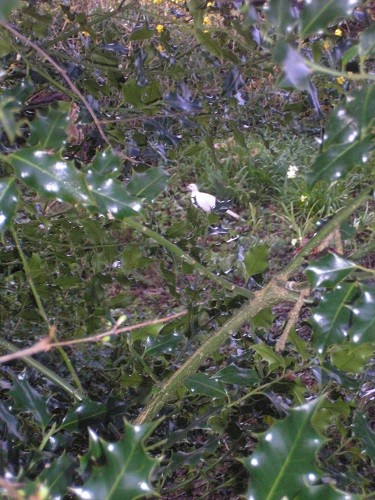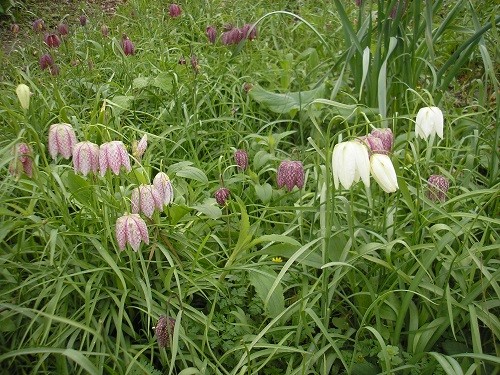You may remember a previous post about our phantom fritillary eater, and I ended up accusing the male pheasant which struts around the garden after waking me at 5 in the morning. The other day, when I went to draw back the bedroom curtains, there in the woodland, in a shaft of sunlight, right by my fritillaries was……….
…..the white female pheasant! I flew downstairs, flung on my wellies and gardening coat as I was still in my pyjamas and crept up behind a holly bush to try and get a photograph, not very good I’m afraid, but the best I could do in the heat of the moment. I made myself as small as I could and crept into the woodland trying to stay behind the trunk of one of the oak trees, sad to say that they are thinner than I am unfortunately! The pheasant had walked to the end of the woodland where she then lay down behind a tussock of grass with just her head showing. I must have been within about 8 ft of her and was just raising the camera when suddenly she was off into the air, flying through the trees, across the garden and into the field. This is the first time we have seen her in the garden and now wonder if it is her causing all the damage to the fritillaries.
One thing I did notice however after she left me, was how many more fritillaries had opened up in the sunshine that we have had lately.
To start with there was just a cluster of pale coloured flowers, but as the days went by, more and more purple flowers opened up, there were lots of buds hiding down below which hadn’t been seen by their protagonist, and therefore escaped being eaten.
Reading various books, it is obvious that I am not the only one who has this problem, Beth Chatto solves her problem by eating them (the pheasants not the flowers!) and various books about bulbs say that pheasants are partial to fritillary flowers. So what can the answer be?
I don’t really want to fence them off, but on the other hand it was so depressing to see the first flowers so chewed. Lots of replacements have now appeared so there will be plenty of seed to sprinkle around. I’m still thinking that maybe the pheasants were tempted because at the time everywhere was frozen solid, no creepy crawlies or juicy worms for them to eat so my fritillaries were next on the menu unfortunately!






Wow, Pauline – it will be a long time before I can aspire to have such beautiful swathes (I was going to write ‘clumps’, but they are so much more than that) of fritillary ……. The range of shades is delightful, and all the more so because of the number of blooms. Were any there when you first had your garden, or were you responsible for the first of the planting? Well done for your early pheasant foray, despite the lack of conclusive evidence; perhaps you are right and she/he/they were only interested in them while there was nothing else.
Cathy, we are back from our holiday and trying to catch up with everything, the first thing I did was to check if I had any fritillaries left, thank goodness there are loads! No, there weren’t any here when we moved, I bought one packet of bulbs and the rest have grown from seed that I sprinkle each year, maybe soon I can sprinkle the seed elsewhere.
I’m glad you’ve managed to find the culprit, but I guess there isn’t really much you can do to stop the pheasant eating them. You’re probably right in that there hasn’t been a lot else available for it to feed on during the cold spells so it came hunting for easy options. You do have a very impressive display of fritillary though, much more than in my garden that has nothing attacking it, so maybe nature will told hold and replace those you’ve lost?
We now have lots more fritillaries flowering Paula, so no problem while we have been away on holiday, thank goodness. There is lots more natural food for them now so, hopefully we will be ok from now on.
Your fritillaries are beautiful pheasant or no pheasant. Pale forms are beginning to form in my garden, and I really like them.
My original bulbs Carolyn, were all purple, the lovely pale shades have come since I started sprinkling the seed, love the ones with two tone shades.
We all have those pj moments – it’s a gardeners thing 🙂
Your fratillaria are beautiful – it’s hardly surprising she is fascinated by them too. Don’t have a solution to your problem, sorry!
Angie, I’m glad I’m not the only one running round the garden in my pjs, thank goodness no one can see me! Nature seems to have sorted out my problem by providing natural food which is now available now that temperatures are climbing and the ground isn’t frozen any more.
Oh dear, and she was such a favoured bird. I suppose she still might be innocent? Fabulous swathes of fritillaries nevertheless Pauline.
She is lovely isn’t she Janet, but she has been behaving while we were away, lots more flowers to enjoy, thank goodness!
One of my favourite bulbs; but I’ve never had a garden where they would grow. Yours are fabulous, I don’t think I’ve ever seen such tight clumps or swathes as Cathy says. so despite the pheasant your fritillary are wonderful. Christina
Thanks Christina, even more have opened while we were away, so the pheasants have been behaving themselves in our absence. So much has opened up in just a week, so much catching up to do!
The fritillaries are beautiful. Perhaps, as you say, the pheasant will find other interesting food to eat now. Here’s hoping!
Nature seems to have sorted out my problem Wendy, lots of natural food for the pheasants to enjoy now that the temperature is rising and the freezing weather hopefully has gone for good.
I think your white pheasants are only a collateral damage that you shall accept when you offer them such an amount of what they are considering food. At the end of the day you have so many fritillaries that you could effort the sacrifice to some ghostly presence in your garden. Some of my fritillaria meleagris have come back this year, although I planted them in a very dry spot. I wish I had a damp place to move them… Or a pheasant for dinner… whatever.
So glad your fritillaries have returned Alberto, some people tell me that they don’t necessarily need damp as long as they aren’t too hot, a bit of shade maybe where you could sprinkle your seed? I was wondering what I would find in the woodland this morning having returned from holiday last night, I needn’t have worried, lots more fritillaries have opened and not been eaten!
How about scattering a few handfuls of corn in an area away from the f’s but still in the woodland? They may prefer it!
It’s certainly a good idea Clare but we have far too many fat wood pigeons who would eat it all up before the pheasants arrive! Nature seems to have solved the problem for me, temperatures are rising and there is more natural food for them to eat at last.
I am so envious of your fritillaries. I have tried to establish them and failed utterly. They are very beautiful
So sorry to hear you have tried and failed with snakeshead fritillaries Elizabeth, where have you been planting them? I found I had a damp area in a little area of woodland here so tried because nothing else survived, they love the dappled shade and the damp soil, thank goodness! Sorry to have been so long replying, but we have been away enjoying a well earned holiday!
I had sparrows eating my newly planted out heartease violas a few weeks ago. I think they’ve been struggling to find food. I think it’s worth seeing what happens next year before fencing them off. They look gorgeous by the way.
So sorry WW that your violas have suffered the same fate as the first of my fritillaries. I now have lots more flowers so the pheasants must have left them alone while we were away and found more natural food to enjoy, hope your violas put out more flower buds. I think nature has sorted the problem out for me by providing natural food now that it has warmed up.
Such a shame about your beautiful flowers – but I think you are correct in thinking that they haven’t had much else to eat recently. Hopefully with the weather picking up there will be a more plentiful supply of food for them and the pheasants will leave your garden alone!
Have you considered putting out a source of food to distract them from your plants? Mealworms and grain are particular favourites of pheasants.
Good to hear from you Birdfeeder, I will certainly bear your idea of food to distract the pheasants in mind for next year, this year seems to have sorted itself out now the temperatures are rising at last and the pheasants seem to be leaving the fritillaries alone. We put mealworms out for the robins, blackbirds and thrushes and have to stand guard because of the fat waddling wood pigeons, they would clear the lot in 5 minutes!!
We have just returned from holiday and now have lots more fritillary flowers, the pheasants have been behaving while we have been away, thank goodness!
Hi Pauline, Your fritillaries are so pretty no wonder they are attracting attention however unwanted. It is always frustrating to lose plants, fruit or flowers to pests. I did not know that birds like pheasants would eat flowers.
I must remember to re-introduce some fritillaries for next year.
Hi Jennifer, nature has made up for the flowers that were eaten. We have just got back from a holiday and so many new flowers have opened, the pheasants haven’t bothered with them while we have been away, thank goodness! I’ve just been reading on someone’s blog that the pheasants in her garden are eating her wood anemones! Do have a go with them next year, they are such lovely flowers.